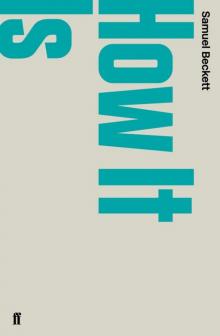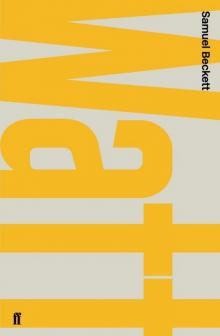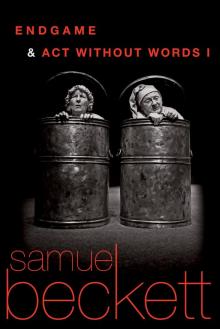- Home
- Samuel Beckett
The Unnamable Page 2
The Unnamable Read online
Page 2
Des mouches. Elles ne sont peut-être pas très nourrissantes, ni d’un goût très plaisant, mais la question n’est pas là, mais ailleurs, loin de l’utile, loin de l’agréable. J’attrape aussi les papillons de nuit, attirés par les lampions, quoique plus difficilement. Mais je n’en suis encore qu’à mes débuts, dans ce nouvel exercice, je suis loin d’avoir atteint mon plafond. (Beckett 1971, p. 76)
The flies. They are perhaps neither very nourishing, nor very pleasant to the taste, but it is not a question of that, but of something else, far from utility or pleasure. I also catch moths, attracted by the lanterns, though with more difficulty. But it is still early days in this new enterprise, I am far from having reached my peak. [My translation]
With the completion of his English translation, Beckett was now in a position to publish all three novels of the Trilogy together. He seems to have been rather ambivalent on this question of its collective designation. Although he wrote to Aidan Higgins in August 1958 that he had always wanted the three novels to appear in one volume, he also informed John Calder on two occasions, in January and December 1958, that he did not wish the word ‘trilogy’ to be used of the books (Pilling 2006, pp. 141, 143). He would write in similarly emphatic terms to Barney Rosset of Grove Press in May 1959. The three texts were first published in one volume by Olympia Press, under the title Molloy, Malone Dies, The Unnamable – A Trilogy and by Grove Press, with the title Beckett himself suggested (Ackerley and Gontarski 2004, p. 596), Three Novels: Molloy, Malone Dies, The Unnamable. The English Calder and Boyars edition appeared in March 1960, though with a 1959 imprint, and, like the Grove Press edition, made no reference to the texts being a trilogy. Nevertheless, the inseparability of The Unnamable from the sequence as a whole, and its role in confirming it as a sustained and completed sequence is suggested by the fact that no separate edition of The Unnamable would become available in Britain until Calder and Boyars issued theirs in 1975.
The Unnamable seems triumphantly to use the extreme conditions of inhibition and impediment that it has set for itself to generate a way of keeping going. But there is no doubt that Beckett did see The Unnamable as a genuine impasse, a point beyond which, for a long time, it seemed impossible for him to go. For this reason, Beckett himself seems to have seen the text as a defining point in his career. In an interview with Israel Schenker, published in the New York Times on 5 May 1956, Beckett referred to his predicament after The Unnamable or, as it still was at that time, L’Innommable:
I wrote all my work very fast – between 1946 and 1950. Since then I haven’t written anything. Or at least nothing that has seemed to me valid. The French work brought me to the point where I felt I was saying the same thing over and over again … In the last book, L’Innommable, there’s complete disintegration. No ‘I’, no ‘have’, no ‘being’. No nominative, no accusative, no verb. There’s no way to go on.
It would be unwise to assume that these are Beckett’s ipsissima verba, since this is simply the report of an interview. But, if Beckett did indeed say that he had not written anything after L’Innommable, ‘the last book’, it is slightly odd that he should do so, for he had in fact published Textes pour rien in November 1955, and had completed early versions of both the play Fin de partie and a mime that would become Acte sans paroles. The Unnamable may have been particularly on Beckett’s mind when he gave this interview in 1956 because he was at that moment struggling to make headway with the English translation of it. It seems as though the novel may have continued to function for Beckett as a kind of recurring limit, or ne plus ultra, even after he had in actual fact put it behind him.
Oddly enough, Beckett had found the escape route even before beginning to write what would become the third text of the Trilogy, for after completing Malone meurt he suspended work on fiction to compose En attendant Godot. This was by no means Beckett’s first attempt at drama, for he had worked for some time on a play about the life of Samuel Johnson, of which only the fragment known as ‘Human Wishes’ survives, and had completed the play Eleuthéria, which he never translated into English and which would not be published until after his death. But it was Waiting for Godot that was to mark the beginning of his involvement in the theatre in earnest.
Beckett would report the sensation of not being able to go on, frequently, throughout the rest of his writing life, but the extreme challenge of finding a way of beginning again after The Unnamable seems to provide the template for these experiences. Nearly all commentators have agreed with Beckett in finding The Unnamable a kind of terminus: the ultimate point of paradoxical intensification, where narrative means have shrunk to nothing, but narration must go on, where there is nothing left to write with or about, and yet somehow the writing manages to continue, consumed by and subsisting only on itself.
Seeing it as, in Michael Robinson’s words, ‘the inevitable and terrifying end’ to his work up to that point (Robinson 1969, p. 191), critics writing of Beckett’s fiction up to the end of the 1970s tended to exhibit a certain stunned, respectful perplexity with regard to the novel. They seem unwilling to do much more than offer more or less simplifying explications or paraphrases of it, relying heavily on extended quotations. Of course such summaries, like those of John Fletcher (Fletcher 1964, pp. 179–94) or Eugene Webb (Webb 1970, pp. 123–9), offered very considerable and much-needed assistance to baffled early readers of the novel (I was one of them). But it was as though the novel’s extreme and unremitting reflexivity, at once exhaustedly and tirelessly ‘on the alert against itself’, made it impossible for criticism to extract itself sufficiently from the novel’s workings to get a critical fix on it from the outside. We might say that critics writing about The Unnamable through the 1960s and 1970s were forced to replicate the condition of Beckett himself, who in 1946 protested his inability to ‘write about’ (Gontarski and Uhlmann 2006, p. 20).
One notable exception to this passivity is Hugh Kenner’s brief account of the novel in 1973. While agreeing that this is a difficult, ‘Zero book’, which, ‘of all the fictions we have in the world, most cruelly reduces the scope of incident, the wealth of character’ (Kenner 1973, p. 112), Kenner nevertheless differs from most other critics, who find in the book a contagious terror, its language on the point of toppling over into pure scream or panicky babble. Kenner, almost uniquely, and perhaps even a touch perversely, finds a kind of extreme composure or ‘calm excellence’ (Kenner 1973, p. 113) in The Unnamable. Here, he thinks, there is none of the knowingness, the winking, slightly exhibitionist excess-to-requirements that is sometimes apparent in the earlier books. Instead, a ‘weary persistence, like the low vitality of the heart that beats during surgery, is setting sentence after sentence with unwavering punctilio’ (Kenner 1973, p. 113). Where others have found passionate intensity in the novel, Kenner focuses on the ‘heroism without drama’ which, more than mere naming, offers declaration, ‘which detaches from the big blooming buzzing confusion this thing, this subject, this’ (Kenner 1973, p. 114) – this being Beckett’s way of combating the Nothing, ‘by a moral quality, by the minimal courage that utters, utters, utters, without moan, without solecism’ (Kenner 1973, p. 115).
Gradually, through the 1970s, another, somewhat more defensive kind of response to The Unnamable emerged. This avoided the temptation of being tugged helplessly into the epistemological vortex of the novel, by regarding it as a kind of allegory. Readings of this sort started to assume that the novel was not really about what it said it was, but teasingly was the staging, or indirect figuration, of some more general set of issues, of a recognisably religious, philosophical, psychological or political nature. Seeing The Unnamable as being about something else seems often to have helped to make it more docile and tractable, assisting the critic in his or her vocation of giving a name to Beckett’s Unnamable, rather than having to be helplessly ventriloquised by it, a predicament that uncomfortably reproduces that of the narrator in the novel. Such criticism insinuates that the secret name of The Unnamable is not esse
ntially inaccessible, but rather withheld. An example of this approach is Hélène Baldwin’s study of religious mysticism in Beckett, which centres on the quest for what, seizing on a phrase from The Unnamable, she calls the ‘real silence’, of Beckett’s work. Baldwin reads the novel as ‘a metaphoric projection of the mystic way’, confidently declaring, for example, that the dim, intermittently lit setting of the novel is ‘undoubtedly the second Dark Night of the Soul’ (Baldwin 1981, p. 69), while the mysterious ‘master’ spoken of in the narrative is ‘undoubtedly Beckett’ (Baldwin 1981, p. 72). And while we’re about it, there can be ‘[n]o question but that the sealed jar is an analogue of the Crucifixion’ (Baldwin 1981, p. 76). In a more recent example of this mode of reading Gary Adelman names the unnamed subject of the text as the Holocaust, finding in its narrator a ‘new figure of epic grandeur for the age of Kafka and the death camps’ (Adelman 2004, p. 84).
Another way of resisting the epistemological vortex of The Unnamable is precisely by construing the text as epistemology itself, or some other more or less formal philosophical exercise. This approach became popular in the 1980s, during which Continental philosophers such as Blanchot, Derrida and Deleuze were drawn upon to demonstrate that Beckett’s work was not only amenable to reading in the light of this philosophy, but actually was itself, reciprocally, already a kind of philosophy. This approach is a feature of the readings of Beckett’s trilogy offered by Leslie Hill (1990) and Thomas Trezise (1990) and, I fear, my own efforts (Connor 1988).
One of the most extraordinary and percipient such readings of The Unnamable had appeared much earlier, but remained latent until reactivated by these philosophical readers of the 1980s. It came from the French critic and philosopher Maurice Blanchot, who had written to Jerome Lindon of Éditions de Minuit in May 1953, asking him for advance proofs of L’Innommable, on which he was planning to write an essay. The essay appeared in the October 1953 issue of the Nouvelle Revue Française under the title ‘Où maintenant? Qui maintenant?’ (Blanchot 1953). Blanchot saw The Unnamable as the work in which Beckett attained the quick or essence of writing, which for Blanchot was something impersonal, indifferent. In order to reach this position, Blanchot wrote, it is necessary for Beckett first to adopt and then to abandon the reassuring masks or subterfuges of plot, character or person. The rudiments of these still survive and reassure us in Molloy and Malone Dies. But in The Unnamable, Blanchot observes: ‘There is no longer any question of characters under the reassuring protection of a personal name, no longer any question of a narrative’ (Blanchot 2000, p. 96). More than this, we are even denied the last resort of stabilising The Unnamable around the inviolable first person of Samuel Beckett, ‘where everything that happens happens with the guarantee of a consciousness, in a world that spares us the worst degradation, that of losing the power to say I’ (Blanchot 2000, p. 96). Rather, Blanchot insists, The Unnamable gets to the heart of things by pressing through, beyond or behind the first person, to the anonymous, tormented space of writing itself, which animates all literature, but is rarely, if ever, able to be grasped directly within the text. Perhaps this means that even the idea of The Unnamable as a single, bounded work is dissolved:
Perhaps we are not dealing with a book at all, but with something more than a book: perhaps we are approaching the movement from which all books derive, that point of origin where, doubtless, the work is lost, the point which always ruins the work, the point of perpetual unworkableness with which the work must maintain an increasingly initial relation or risk becoming nothing at all. (Blanchot 2000, p. 97)
But in seeming to disallow the fixing down or location in a specific source of The Unnamable, Blanchot nevertheless assimilates the text to his own philosophy, of the ‘neutral’, or the ‘indifferent’, anticipating the moves made by philosophical critics of the 1980s and beyond.
For critics who tend towards the philosophical readings I have just been describing, and who tend to see Beckett’s major achievement as concentrated in his prose, The Unnamable has a special status as a kind of abstract or encyclopedia of Beckettian themes and feelings, the fullest and most unflinching enactment of the ‘issueless predicament’ that his work in general explores. Such critics tend to treat The Unnamable as the matrix, or omphalos, around which all the rest of Beckett’s work, both before and after, inevitably swirls, as though Joe, Winnie and all the rest of Beckett’s post-Unnamable creatures were destined to join Molloy and Malone in their concentric orbits around this novel’s dubiously spectatorial speaker.
But there have been other readers who have seen the very extremity of The Unnamable, its maximum of minimality, as providing the decisive impetus for the thirty years of new and improbably various ways of ‘going on’ that succeeded it. For such critics, ‘going on’ has meant ‘going beyond’, or even getting out from under, The Unnamable. Perhaps the most influential of these critics in recent years has been the philosopher Alain Badiou. Badiou agrees with other critics in seeing The Unnamable as a climax in Beckett’s work. However, Badiou attempts to alter the centre of gravity of Beckett studies, by directing attention to the kind of work that followed upon The Unnamable. For Badiou, this is work that is no longer skewered on the unresolvable excruciations of what the subject is and how it is to be spoken, but deals instead with what he calls the ‘occurrences’ of the subject, most notably in its encounters with otherness. ‘Instead of the useless and unending fictive reflection of the self’, writes Badiou, ‘the subject will be pinpointed according to the variety of its dispositions vis-à-vis its encounters – in the face of “what-comes-to-pass”, in the face of everything that supplements Being with the instantaneous surprise of an Other’ (Badiou 2003, p. 16).
Badiou describes himself as encountering Beckett through The Unnamable during the 1950s, and being captivated by the vision he found there of nothingness and dereliction, a vision that ‘rather suited the young cretin I was at the time’ (Badiou 2003, p. 39). Forty years later, Badiou dismisses this view as ‘a caricature’. In urging that we follow Beckett in moving beyond The Unnamable, Badiou is also urging a move beyond the kind of language-centred post-structuralist criticism that finds in The Unnamable its most complete statement of principle, caught as it is in the same infatuation, the same ‘Cartesian terrorism’ (Badiou 2003, p. 55). In writing that ‘[i]t was important that the subject open itself up to an alterity and cease being folded upon itself in an interminable and torturous speech’ (Badiou 2003, p. 55), and insisting that Beckett had in fact done so, Badiou is also reproving a generation of critics who have found in The Unnamable what he sees as a sterile model for self-replicating and ultimately self-satisfied scepticism.
Perhaps Beckett never again made such intense demands on himself or his readers as he does in The Unnamable. When he turned back to prose in earnest, it was in a very different manner from what he had discovered in The Unnamable, which, in this sense, at least, remains a kind of ne plus ultra. This is not quite to say that it had no issue, for in some ways the novel might be said to have seeded many of the later works. The monologue Not I, for example, may be seen as another attempt to dramatise the obstinate abstention from being that characterises the novel. In this sense, The Unnamable remains at the enigmatic heart of Beckett’s writing, and of critical writing about Beckett.
References
Ackerley, Chris and S.E. Gontarski (2004). The Grove Companion to Samuel Beckett: A Reader’s Guide to His Works, Life, and Thought. New York: Grove Press.
Adelman, Gary (2004). Naming Beckett’s Unnamable. Lewisburg: Bucknell University Press/London: Associated University Presses.
Admussen, Richard L. (1979). The Samuel Beckett Manuscripts: A Study. Boston, MA: G.K. Hall and Co.
Badiou, Alain (2003). On Beckett. Trans. Nina Power and Alberto Toscano. London: Clinamen Press.
Badiou, Alain (1995). Beckett: L’increvable desir. Paris: Hachette.
Baldwin, Hélène L. (1981). Samuel Beckett’s Real Silence. University Park, PA and London: Penns
ylvania State University Press.
Beckett, Samuel (1958a). ‘The Unnamable.’ Texas Quarterly, 1, pp. 129–31
——— (1958b). ‘Excerpt: The Unnamable.’ Chicago Review, 12.2, pp. 82–6.
——— (1958c). ‘The Unnamable.’ Spectrum (Santa Barbara), 2, pp. 3–7.
——— (1959a). Molloy. Malone Dies. The Unnamable. A Trilogy. Paris: Olympia Press.
——— (1959b). Molloy. Malone Dies. The Unnamable. London: Calder and Boyars.
——— (1971). L’Innommable. Paris: Éditions de Minuit.
Blanchot, Maurice (1953). ‘Où maintenant? Qui maintenant?’ Nouvelle Revue Française, 2, pp. 678–86.
——— (2000) ‘Where Now? Who Now?’ Trans. Richard Howard. Reprinted in Samuel Beckett, ed. Jennifer Birkett and Kate Ince (London and New York: Longman), pp. 93–8.
Connor, Steven (1988). Samuel Beckett: Repetition, Theory and Text. Oxford: Blackwell.
Gontarski, S.E and Anthony Uhlmann, eds. (2006). Beckett After Beckett. Gainesville: University of Florida Press.
Hill, Leslie (1990). Beckett’s Fiction: In Different Words. Cambridge: Cambridge University Press.
Kenner, Hugh (1973). A Reader’s Guide to Samuel Beckett. London: Thames and Hudson.
Pilling, John (2006). A Samuel Beckett Chronology. Houndmills: Macmillan Palgrave.
Robinson, Michael (1969). The Long Sonata of the Dead: A Study of Samuel Beckett. London: Hart-Davis.
Trezise, Thomas (1990). Into the Breach: Samuel Beckett and the Ends of Literature. Princeton, NJ: Princeton University Press.
Webb, Eugene (1970). Samuel Beckett: A Study of His Novels. London: Peter Owen.

 More Pricks Than Kicks
More Pricks Than Kicks Happy Days
Happy Days Breath, and Other Shorts
Breath, and Other Shorts Endgame & Act Without Words
Endgame & Act Without Words The Collected Shorter Plays of Samuel Beckett
The Collected Shorter Plays of Samuel Beckett The Complete Short Prose, 1929-1989
The Complete Short Prose, 1929-1989 Stories and Texts for Nothing
Stories and Texts for Nothing Waiting for Godot
Waiting for Godot Rockaby and Other Short Pieces
Rockaby and Other Short Pieces First Love and Other Shorts
First Love and Other Shorts How It Is
How It Is Disjecta: Miscellaneous Writings and a Dramatic Fragment
Disjecta: Miscellaneous Writings and a Dramatic Fragment Echo's Bones
Echo's Bones Texts for Nothing and Other Shorter Prose 1950-1976
Texts for Nothing and Other Shorter Prose 1950-1976 Three Novels
Three Novels Murphy
Murphy Mercier and Camier
Mercier and Camier Eleuthéria
Eleuthéria Selected Poems 1930-1988
Selected Poems 1930-1988 Dream of Fair to Middling Women
Dream of Fair to Middling Women Watt
Watt Krapp's Last Tape and Other Dramatic Pieces
Krapp's Last Tape and Other Dramatic Pieces The Complete Dramatic Works of Samuel Beckett
The Complete Dramatic Works of Samuel Beckett Worstward Ho
Worstward Ho Collected Poems in English and French
Collected Poems in English and French Company / Ill Seen Ill Said / Worstward Ho / Stirrings Still
Company / Ill Seen Ill Said / Worstward Ho / Stirrings Still Ends and Odds
Ends and Odds Endgame Act Without Words I
Endgame Act Without Words I Rockabye and Other Short Pieces
Rockabye and Other Short Pieces The Collected Shorter Plays
The Collected Shorter Plays The Complete Dramatic Works
The Complete Dramatic Works Three Novels: Malloy, Malone Dies, The Unnamable
Three Novels: Malloy, Malone Dies, The Unnamable The Unnamable
The Unnamable